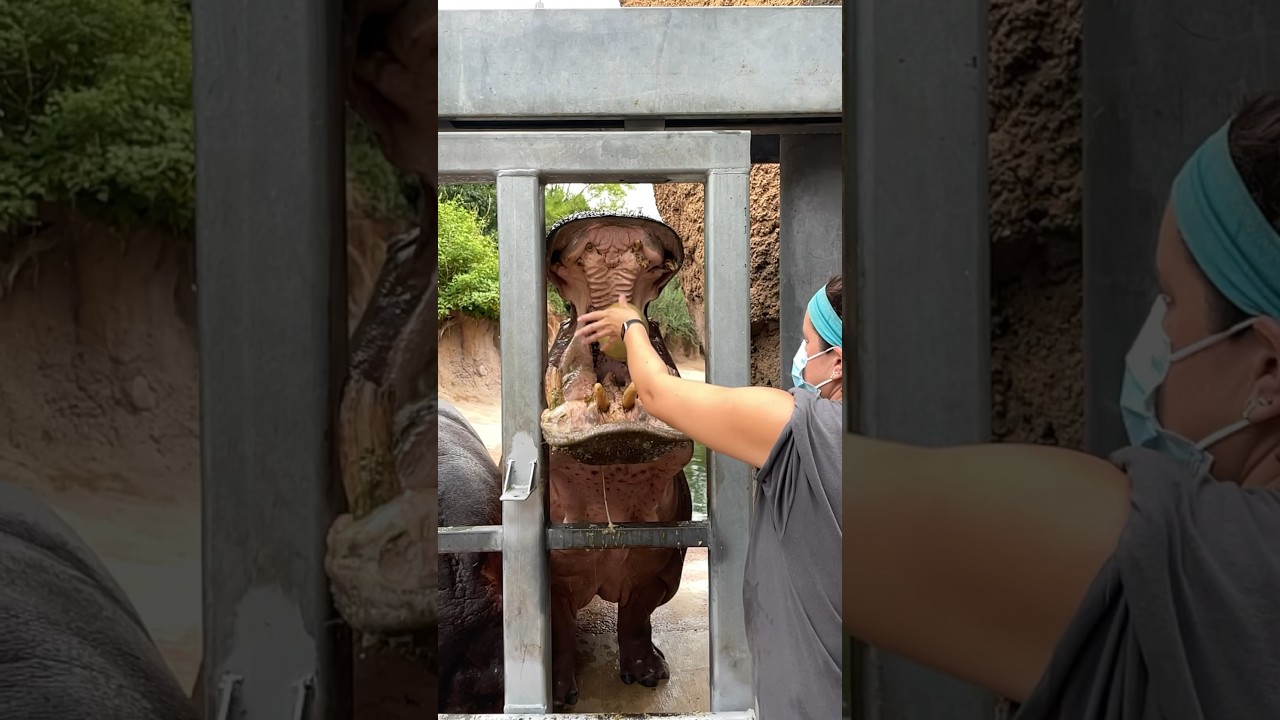– The surprising dietary preferences of hippos and the role of fruit in their diet
– Interesting behaviors exhibited by hippos, such as their playful interactions with food
– The importance of enrichment activities for animals in captive settings like zoos
– How witnessing animal behavior allows a glimpse into their personalities and natural habits
Images of a colossal creature lazily submerged in African rivers might come to mind when one thinks of the mighty hippopotamus, or ‘river horse,’ as the ancient Greeks named it. Yet, there’s so much more about these impressive animals beneath the surface, literally and figuratively. Take, for instance, the scene that’s been charming animal enthusiasts worldwide, Uma. The hippo is playfully crushing a cantaloupe as if it were little more than a grape. The sight is entertaining and opens the door to a deeper understanding of the natural world and the daily lives of one of its most fascinating inhabitants.
At first glance, the diet of a hippopotamus can seem quite straightforward. These behemoths are primarily known as herbivores, grazing on grasses for hours each night. But when it comes to their occasional dalliance with fruit, it appears there’s a sweet side to these hefty herbivores. It’s a little-known fact that hippos can eat fruit and consume it in the wild, albeit not as a staple of their diet. Seasonally, when fruit might drop into their waterways from overhanging trees, hippos have been known to indulge in this sweeter fare. What’s intriguing about Uma’s enthusiastic cantaloupe squashing moment is that it highlights the versatility and adaptability of hippos in their eating habits.
Delving deeper into the playful aspect of Uma’s interaction with the cantaloupe, one might wonder if this is normal behavior. The answer lies in understanding the social and cognitive attributes of these creatures. Hippos are surprisingly social animals, forming groups called bloats, where interactions can include vocalizations, physical posturing, and, yes, even play. Observing a hippo engage with objects seemingly spiritedly suggests cognitive complexity at work. It’s believed that play is a sign of higher animal intelligence, offering mental stimulation and even helping to establish social bonds.
For hippos under human care, such as Uma, encountering various objects or foods is more than just luck; it results from careful and thoughtful enrichment provided by those who oversee their well-being. Zoos and animal sanctuaries often incorporate enrichment activities into their animals’ daily lives, which provide mental and physical stimulation and emulate conditions the animal would encounter in the wild. Watching Uma with her cantaloupe is a cheerful reminder of the value of such practices. It’s not just about nutrition; it’s about allowing animals to engage in inherent and natural behaviors, thus enhancing their overall welfare.
The narrative extends even further when we frame these activities within the context of zoo-based conservation and education. As onlookers marvel at these moments of animal charm, they also unwittingly learn about hippo biology and their ecological role. Each engaging action has the potential to inspire a deeper respect and appreciation for wildlife and the efforts in place to protect it. Herein lies the power of these shared moments; they can motivate individuals to become more informed and possibly take action in conservation efforts.
The ‘cute’ factor of Uma’s melon moment should not overshadow the reality and importance of habitat conservation for wild hippos. Sub-Saharan Africa, the native habitat of hippos, has experienced various threats from human activity, including habitat loss, water pollution, and poaching. By connecting with audiences through these seemingly light-hearted vignettes, conservation organizations can use these points of engagement as a gateway to discuss more serious issues affecting wildlife.
Furthermore, with their semi-aquatic lifestyle, hippos are key players in their ecosystems, often affecting the dynamics of the rivers and lakes they inhabit. Known to travel on well-worn paths to and from their nightly feeding grounds, they shape the landscape, dispersing seeds and fertilizing the land with nutrient-rich waste. Enlightening viewers to the multi-faceted roles these animals play helps foster an understanding of the delicate balance within ecosystems and the importance of each species.
Shifting focus back to Uma, a resident of her aquatic abode under human care, she unwittingly becomes an ambassador for her wild counterparts. Her carefree crushing of fruit echoes the need for humans to recognize our responsibilities towards animals in and out of the wild. It emphasizes the important work that zoological institutions do in research, conservation, and education.
Still, it’s crucial to recognize that these moments captured and shared across the internet are snapshots of a much larger picture. Behind each viral video lies a complex network of care, scientific inquiry, and conservation messaging, all working to ensure that species like hippos continue to thrive in the wild and inspire future generations.
In considering the full scope of the cantaloupe saga, one can glean lessons about adaptability, playfulness, ecological importance, and the role of zoological institutions. While a single moment can be delightful, the broader narrative must be championed, celebrated, and supported.
For those fortunate enough to observe and share in the joy of Uma’s entertaining display, let this be a reminder of the beauty and intricacy of our natural world. Let it urge us to learn more, care more deeply, and act to conserve all creatures – from the largest hippopotamus to the smallest insect. Through these shared experiences, may our collective awe and wonder lead us toward a more harmonious coexistence with the rich tapestry of life surrounding us.
*****
Source Description


